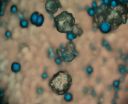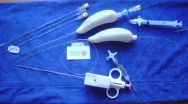HOUSTON, TX, February 27, 2014 (Press-News.org) Invasive and systemic cancer treatment is a necessary evil for many people with the devastating diagnosis. These patients endure therapies with ravaging side effects, including nausea, immune suppression, hair loss and even organ failure, in hopes of eradicating cancerous tissues in the body. If treatments targeted a patient's cancerous tissues, it could provide clinicians with an alternative to lessen the delivery of toxic levels of chemotherapy or radiation. Imagine the quality of life from such therapies for patients. Remarkably, research that began in space may soon result in such options here on Earth.
As we recognize February as National Cancer Prevention Month, it is useful to also point out the continuous improvements to cancer treatment through research and discovery. Using the distinctive microgravity environment aboard the International Space Station, a particular series of research investigations is making further advancements in cancer therapy. A process investigated aboard the space station known as microencapsulation is able to more effectively produce tiny, liquid-filled, biodegradable micro-balloons containing specific combinations of concentrated anti-tumor drugs. Using specialized needles, doctors can deliver these micro-balloons, or microcapsules, to specific treatment sites within a cancer patient. This kind of targeted therapy may soon revolutionize cancer treatment delivery.
Use of the microgravity environment aboard the space station for microencapsulation experiments was a necessity before the ability to develop an Earth-based technology for making these microcapsules. "The technique that we have for making these microcapsules could not be done on the ground, because the different densities of the liquids would layer," explained Dennis Morrison, Ph.D., retired NASA principal investigator of the Microencapsulation Electrostatic Processing System-II (MEPS-II) study and current vice president and director for microencapsulation research and development at NuVue Therapeutics, Inc. "But in space, since there is not sedimentation due to gravity, everything goes spherical."
The MEPS operations in microgravity brought together two liquids incapable of mixing on Earth (80 percent water and 20 percent oil) in such a way that spontaneously caused liquid-filled microcapsules to form as spherical, tiny, liquid-filled bubbles surrounded by a thin, semipermeable outer membrane.
In space, surface tension shapes liquids into spheres. Each molecule on a liquid's surface is pulled with equal tension by its neighbors. The closely integrated molecules form into the smallest possible area, which is a sphere. In effect, the MEPS-II system allowed a combination of liquids in a bubble shape because surface tension forces took over and allowed the fluids to interface rather than sit atop one another.
"We were able to figure out what parameters we needed to control so we could make the same kind of microcapsules on the ground," said Morrison. "Now, we no longer have to go to space. Space was our teacher, our classroom to figure out how we could make these on Earth."
Though the MEPS-II technology was produced on the space station in 2002, the ensuing global economic struggles and funding hurdles made it difficult to raise investor capital for new clinical trials of the microcapsules in humans. This gap in the research slowed movement from discovery to an actual product that improves human health.
The MEPS-II system is now being brought to commercial scale under U.S. Food and Drug Administration (FDA) Good Manufacturing Practice requirements by NuVue. NuVue exclusively licensed the MEPS technology for medical uses, including the treatment of cancer. These cancer therapies are now the subject of several patents and patent pending applications.
Commercialization of the MEPS technology and methods to develop new applications for these unique microcapsules has already begun. The space station research led to 13 licensed microcapsule-related patents and two that are pending. In addition, NuVue has designed devices integrating the delivery of the MEPS-II microcapsules with enhanced ultrasound visualization and cryotherapeutic effects, which are the subject of four additional issued and three pending patents.
NuVue also is currently seeking FDA approval of MEPS microcapsules containing pharmaceuticals and marker imaging agents to view MEPS microcapsules during ultrasound. Fortunately, the MEPS microcapsules were made in NASA labs for the space station under stringent conditions comparable to those of existing FDA requirements.
Through the use of NuVue's specialized biopsy needles working in concert with their enhanced ultrasound guided visualization technology, the needles are visible by an ultrasound imaging system. This allows for a targeted and site-specific approach of the MEPS microencapsulated drug delivery to the tumor. With this targeted approach, the MEPS microcapsules reduce the amount of unpleasant side effects of chemotherapy, whereas normal chemotherapy involves pharmaceutical injection into the entire body to treat cancer cells present in a patient. The microcapsules can also include a combination of drugs tailored to a specific patient, and they can be engineered for time release, providing longer-lasting therapeutic effects within the patient's cancerous tissues.
"Overall, this amounts to a combination of unique things that individually work, but put together work much better," said Morrison. "Microcapsules are a device that can be used together with ultrasound needles to mark the biopsy site for diagnosis. They can also mark the perimeter and margin of the tumor. When properly implemented, ultrasound can monitor the progress of any tumor therapy with the new MEPS marker imaging microcapsules being positioned within the tumor tissues, even if the therapeutic delivered was not through the use of the MEPS microencapsulation process."
In laboratory testing, MEPS-II microcapsules containing anticancer drugs were injected directly into a human prostate and lung tumors in animal models. These models were then, in follow on tests, also injected following the delivery of specific cryo-surgical effects, similar to a freeze and thaw effect on the tumorous tissues. Injecting the microcapsules directly into the tumor demonstrated improved site-specific therapeutic results and the inhibition of tumor growth. Following cryo-surgery, the microcapsules demonstrated improved destruction of the tumor better than freezing or local chemotherapy alone.
Though Morrison's previous laboratory studies of microcapsules were primarily focused on prostate and lung cancer, his studies now target breast cancer for the FDA approval process. Though it will take a few years to get approval to use the microcapsules as a treatment option filled with anti-tumor drug therapies, several devices that will aid in drug delivery are planned for pre-clinical study as early as next year. NuVue's ultrasound-enhanced needles and the imaging marker microcapsules, which do not contain drugs, can be combined for use within the cancer patient.
After achieving full FDA approval, planned clinical trials will involve injecting the microcapsules with the anti-tumor drugs directly into tumor sites in humans at both MD Anderson Cancer Center in Houston and the Mayo Cancer Center in Scottsdale, Ariz. Given the success in animal models in laboratory studies with human prostate and lung tumor treatment, Morrison has high hopes in the near future, of being able to begin use of the microcapsule treatment in breast cancer.
As stipulated by Morrison and the NuVue research team, "these technologies were only able to come to fruition because of the availability of the microgravity environment aboard the space station. Without it, this innovative breakthrough involving the microencapsulation technology process would have never been created."
Just as microgravity can aid in the discovery of new technologies for cancer treatment, these microcapsules may one day aid in the recovery of breast and other specific deep tissue cancers.
Laura Niles
International Space Station Program Science Office and Public Affairs Office
NASA Johnson Space Center
Cancer-Targeted Treatments from Space Station Discoveries
A process investigated aboard the space station known as microencapsulation is able to more effectively produce tiny, liquid-filled, biodegradable micro-balloons containing specific combinations of concentrated anti-tumor drugs.
2014-02-27
ELSE PRESS RELEASES FROM THIS DATE:
Smart SPHERES Are About to Get A Whole Lot Smarter
2014-02-27
Smart devices - such as tablets and phones - increasingly are an essential part of everyday life on Earth. The same can be said for life off-planet aboard the International Space Station. From astronaut tweets to Google+ Hangouts, our reliance on these mobile and social technologies means equipment and software upgrades are an everyday occurrence - like buying a new pair of shoes to replace a pair of well-worn ones.
That's why the Intelligent Robotics Group at NASA's Ames Research Center in Moffett Field, Calif., with funding from the Technology Demonstration Missions ...
Pulling problem teeth before heart surgery to prevent infection may be catch-22
2014-02-27
Rochester, Minn. — Feb. 27, 2014 — To pull or not to pull? That is a common question when patients have the potentially dangerous combination of abscessed or infected teeth and the need for heart surgery. In such cases, problem teeth often are removed before surgery, to reduce the risk of infections including endocarditis, an infection of the inner lining of the heart that can prove deadly. But Mayo Clinic research suggests it may not be as simple as pulling teeth: The study found that roughly 1 in 10 heart surgery patients who had troublesome teeth extracted before ...
Childhood adversity launches lifelong relationship and health disadvantage for black men
2014-02-27
WASHINGTON, DC, February 24, 2014 — Greater childhood adversity helps to explain why black men are less healthy than white men, and some of this effect appears to operate through childhood adversity's enduring influence on the relationships black men have as adults, according to a new study in the March issue of the Journal of Health and Social Behavior.
"Our findings suggest that childhood adversity launches a lifelong process of relationship and health disadvantage for black men," said lead author Debra Umberson, a professor of sociology and a faculty associate in ...
Despite recession, children's health spending increased between 2009-2012, says new report
2014-02-27
Washington, DC – Spending on health care for children covered by employer-sponsored insurance (ESI) increased between 2009 and 2012, rising an average 5.5 percent a year, with more dollars spent on boys than girls, and higher spending on infants and toddlers (ages 0-3) than any other children's age group, finds a new report released today by the Health Care Cost Institute (HCCI). Per capita spending on children reached $2,437 in 2012, a $363 increase from 2009. The study shows a growth in prescription use by children through age 18, as well as a rise in the number of teens ...
Simple lab-based change may help reduce unnecessary antibiotic therapy, improve care
2014-02-27
[EMBARGOED UNTIL THURSDAY, FEB. 27] A simple change in how the hospital laboratory reports test results may help improve antibiotic prescribing practices and patient safety, according to a pilot, proof-of-concept study published in Clinical Infectious Diseases and now available online. No longer routinely reporting positive urine culture results for inpatients at low risk for urinary tract infections (UTIs) greatly reduced unnecessary antibiotic prescriptions and did not affect the treatment of patients who did need antibiotics, the study authors found.
Urine cultures ...
One in 5 US hospitals don't put hand sanitizer everywhere needed to prevent infections
2014-02-27
(NEW YORK, NY, February 27, 2014) – Approximately one in five U.S. health facilities don't make alcohol-based hand sanitizer available at every point of care, missing a critical opportunity to prevent health care-associated infections, according to new research from Columbia University School of Nursing and the World Health Organization (WHO) published in the American Journal of Infection Control. The study, which examined compliance with WHO hand hygiene guidelines in the U.S., also found that only about half of the hospitals, ambulatory care, and long-term care facilities ...
Scientists wake up to causes of sleep disruption in Alzheimer's disease
2014-02-27
Being awake at night and dozing during the day can be a distressing early symptom of Alzheimer's disease, but how the disease disrupts our biological clocks to cause these symptoms has remained elusive.
Now, scientists from Cambridge have discovered that in fruit flies with Alzheimer's the biological clock is still ticking but has become uncoupled from the sleep-wake cycle it usually regulates. The findings – published in Disease Models & Mechanisms – could help develop more effective ways to improve sleep patterns in people with the disease.
People with Alzheimer's ...
Over 80s often over-treated for stroke prevention
2014-02-27
People in their 80s are often prescribed drugs to ward off a stroke when the risk of a stroke is not that high and the drugs have other side effects, finds a perspective published online in Evidence Based Medicine.
People in this age group are being "over-treated," and doctors need to actively rethink their priorities and beliefs about stroke prevention, argues Dr Kit Byatt of the Department of Geriatric Medicine, The County Hospital in Hereford, UK.
Statins and antihypertensive drugs were the most commonly prescribed cardiovascular drugs in the UK in 2006. And they ...
Mental health of most UK troops serving in Afghanistan and Iraq is 'resilient'
2014-02-27
Despite prolonged combat missions to Iraq and Afghanistan, there has been no overall increase in mental health problems among UK soldiers, finds a review of the available evidence, published online in the Journal of the Royal Army Medical Corps.
But certain groups of soldiers do seem to be more vulnerable to mental ill health on their return home, while alcohol problems continue to give cause for concern among regulars, say the researchers from King's College London.
They retrieved published research looking at the psychological impact of deployment to Iraq and Afghanistan ...
Passive smoking linked to increased miscarriage, stillbirth, and ectopic pregnancy risk
2014-02-27
Passive smoking is linked to a significantly increased risk of miscarriage, stillbirth and ectopic pregnancy, finds a large observational study, published online in Tobacco Control.
The risk appears to be cumulative, with risk heightened in parallel with the length of time exposed to second hand smoke, the findings indicate.
It is well known that smoking during pregnancy significantly increases the risks of miscarriage and birth complications. What is less clear is whether passive smoking exerts similar effects, and if there are particularly critical periods of exposure ...
LAST 30 PRESS RELEASES:
University of Oklahoma researcher awarded funding to pursue AI-powered material design
Exploring how the visual system recovers following injury
Support for parents with infants at pediatric check-ups leads to better reading and math skills in elementary school
Kids’ behavioral health is a growing share of family health costs
Day & night: Cancer disrupts the brain’s natural rhythm
COVID-19 vaccination significantly reduces risk to pregnant women and baby
The role of vaccination in maternal and perinatal outcomes associated with COVID-19 in pregnancy
Mayo Clinic smartwatch system helps parents shorten and defuse children's severe tantrums early
Behavioral health spending spikes to 40% of all children’s health expenditures, nearly doubling in a decade
Digital cognitive behavioral treatment for generalized anxiety disorder
Expenditures for pediatric behavioral health care over time and estimated family financial burden
Air conditioning in nursing homes and mortality during extreme heat
The Alps to lose a record number of glaciers in the next decade
What makes a good proton conductor?
New science reporting guide published for journalists in Bulgaria
New international study reveals major survival gaps among children with cancer
New science reporting guide published for journalists in Turkey
Scientists develop a smarter mRNA therapy that knows which cells to target
Neuroanatomy-informed brain–machine hybrid intelligence for robust acoustic target detection
Eight SwRI hydrogen projects funded by ENERGYWERX
The Lundquist Institute and its start-up company Vitalex Biosciences Announces Strategic Advancement of Second-Generation fungal Vaccine VXV-01 through Phase 1 Trials under $40 Million Competitive Con
Fine particles in pollution are associated with early signs of autoimmune disease
Review article | Towards a Global Ground-Based Earth Observatory (GGBEO): Leveraging existing systems and networks
Penn and UMich create world’s smallest programmable, autonomous robots
Cleveland researchers launch first major study to address ‘hidden performance killer’ in athletes
To connect across politics, try saying what you oppose
Modulating key interaction prevents virus from entering cells
Project explores barriers to NHS career progression facing international medical graduates
Jeonbuk National University researchers explore the impact of different seasonings on the flavor perception of Doenjang soup
Two Keck Medicine of USC Hospitals named Leapfrog Top Teaching Hospitals
[Press-News.org] Cancer-Targeted Treatments from Space Station DiscoveriesA process investigated aboard the space station known as microencapsulation is able to more effectively produce tiny, liquid-filled, biodegradable micro-balloons containing specific combinations of concentrated anti-tumor drugs.




